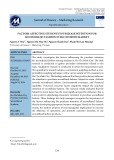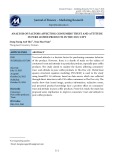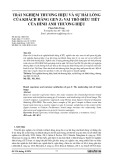
Copyright © 2006 by South-Western, a division of Thomson Learning, Inc. All rights reserved.
Part 3: Target Market
Part 3: Target Market
Selection
Selection
8. Marketing Research Decision-
Support Systems, and Sales
Forecasting
9. Market Segmentation, Targeting,
and Positioning
10.Relationship Marketing,
Customer Relationship
Management (CRM), and One-to-
One Marketing

Copyright © 2006 by South-Western, a division of Thomson Learning, Inc. All rights reserved.
Chapter 8
Chapter 8
Marketing
Marketing
Research, Decision-
Research, Decision-
Support Systems,
Support Systems,
and Sales
and Sales
Forecasting
Forecasting

8-3
Copyright © 2006 by South-Western, a division of Thomson Learning, Inc. All rights reserved.
Chapter Objectives
Chapter Objectives
1. Describe the development of the marketing research function and
its major activities.
2. Explain the steps in the marketing research process
3. Distinguish between primary and secondary data and identify the
sources of each type.
4. Explain the different sampling techniques used by marketing
researchers.
5. Identify the methods by which marketing researchers collect
primary data.
6. Explain the challenges of conducting marketing research in
global markets.
7. Outline the most important uses of computer technology in
marketing research.
8. Explain how the use of information technology, particularly
marketing decision support systems (MDSSs), can enhance and
refine market research and it’s impact on decision making.
9. Identify the major types of forecasting methods.

8-4
Copyright © 2006 by South-Western, a division of Thomson Learning, Inc. All rights reserved.
The Marketing Research Function
The Marketing Research Function
Marketing research: the process of collecting and
using information for marketing decision-making
Development of the Marketing Research
Development of the Marketing Research
Function
Function
First organized marketing research project done
by N.W. Ayer in 1879
First commercial research department in the U.S.
established by Charles C. Parlin for the Curtis
Publishing Co. in 1911
Parlin counted soup cans in garbage to convince
the Campbell soup Company that working-class
families would buy canned soup

8-5
Copyright © 2006 by South-Western, a division of Thomson Learning, Inc. All rights reserved.
Who Conducts Marketing Research
Who Conducts Marketing Research
The size and organizational form of the
marketing research function is typically tied
to a given company’s structure
Many firms depend on independent
marketing research firms
Syndicated Services
Syndicated Services
Organizations that regularly provide
a standardized set of data to all
customers



![Cẩm nang Mỹ thuật và kỹ thuật ứng dụng trong marketing [Chuẩn SEO]](https://cdn.tailieu.vn/images/document/thumbnail/2025/20250714/vijiraiya/135x160/224_cam-nang-my-thuat-va-ky-thuat-ung-dung-trong-marketing.jpg)






















